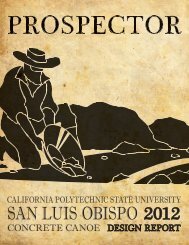Form Design Drawing - Concrete Canoe
Form Design Drawing - Concrete Canoe
Form Design Drawing - Concrete Canoe
Create successful ePaper yourself
Turn your PDF publications into a flip-book with our unique Google optimized e-Paper software.
The team determined the 2011 project schedule using Table 5: Variances in Major Milestones.<br />
Battle Born as a baseline. Black�Diamond’s critical Milestone Variance Cause<br />
path, along with planned and actual dates of completion, is Final Mix Selection 17 days Member Inexperience<br />
indicated on Page 8. Major milestones included final <strong>Canoe</strong> Completion 2 days Delay in Staining<br />
mixture selection, analysis completion, canoe casting,<br />
prestress tendon release, form removal, and canoe completion. Variances of these tasks are presented<br />
in Table 5. The project manager notified lead managers three weeks in advance of each task deadline,<br />
and weekly team meetings ensured the project schedule stayed on-track. Risk management was<br />
implemented by allotting additional time and budget to teach new members appropriate techniques and<br />
to account for possible delays. The team discussed proper methods of preparation and safety measures<br />
before every task, and the safety lead manager implemented safety standards for<br />
each phase of the project and updated Material Safety Data Sheets when<br />
necessary.<br />
Figure 6: Grade<br />
Screw for Depth<br />
Control and Tendon<br />
Path.<br />
The construction team began the year by assembling the steel work table, made<br />
in 2008, and preparing last year’s polyurethane foam mold to minimize cost and<br />
promote sustainability. The team applied two layers of the mold primer<br />
Duratec ® and wax to facilitate an easy canoe removal from the form.<br />
Reinforcement placement began with securing four threaded rods in the center<br />
of each rib location. Grade screws, which doubled as depth control gauges and<br />
prestress tendon paths, were drilled into the form (Figure 6). Clear acrylic square<br />
rods were also used as a base for the gunwale and quality control. The team used construction cut<br />
sheets, generated by the analysis engineer, to improve tendon placement accuracy. Fourteen<br />
longitudinal prestressing tendons were placed on the form, followed by a layer of heat-formed carbon<br />
fiber grid on the sidewalls and two layers on the bottom. The team secured nine transverse prestress<br />
tendons that were tensioned using compression springs. To complete the reinforcement, steel mesh was<br />
used at the bow and stern due to its high malleability.<br />
Monolithic casting of the canoe began by hand-packing concrete through the<br />
reinforcement; this technique allowed the team to prestress the canoe, pre-place<br />
reinforcement to the required specifications and cast the canoe in a single layer,<br />
preventing delamination of the final product. Two experienced mixing teams<br />
batched concrete simultaneously and veteran members oversaw the casting process<br />
as a quality control measure for a consistent 0.5” thickness. Vibrating trowels, a<br />
Nevada innovation, were used to improve consolidation of the concrete. After<br />
casting, the canoe was covered with wet sheets and wrapped in Visquine.<br />
Finishing began with iterations of sanding and patching after seven days of curing.<br />
Fourteen days after the original casting day, longitudinal and transverse tendons<br />
Figure 7:<br />
Exposed<br />
Reinforcement.<br />
were released and cut, and concrete was cast over the exposed tendon ends. However, the team noticed<br />
a transverse crack 6” from the stern of the canoe. After tendon release, the crack propagated into the<br />
chine while another crack became evident near the bow. The team investigated possible reasons for the<br />
cracking, concluding that either: (1) the wood support underneath the bulkhead at the bow and the<br />
stern adhered to the concrete causing tensile stresses; (2) forces were not evenly applied to all sides<br />
during form removal; or (3) the parabolic shape of the tendon paths generated stresses at the ends. The<br />
team’s managers decided to remove the concrete around the crack, exposing the steel mesh<br />
reinforcement (Figure 7), and then cast a larger bulkhead to support the area.<br />
Next, the team built a slotted wooden frame to simultaneously place five manufactured plastic crosssectional<br />
templates at 1’ intervals over the canoe to administer an average depth control, as discussed<br />
in the Innovation and Sustainability section. Finally, the team placed a stencil illustrating the winter<br />
5




